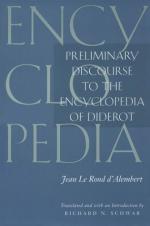|
This section contains 374 words (approx. 2 pages at 300 words per page) |
World of Scientific Discovery on Jean le Rond D' Alembert
D'Alembert was abandoned by his parents shortly after birth and was found on the doorstep of the church of St. Jean-le-Rond. He was the illegitimate son of an aristocrat who, despite having given up the young D'Alembert, arranged for his financial support in later years. D'Alembert grew up well provided for and attended Mazarin College where he studied law and eventually took up legal practice in 1738, but his heart was not in his work and he spent a year studying medicine and other scientific pursuits.
He decided to devote his life to mathematics and succeeded brilliantly. His first published mathematical paper, in 1739, was on the subject that fascinated him the most throughout his life: integral calculus. D'Alembert's work on this subject, which generated several papers published in the prestigious Memoires of the Academy of Berlin, was crucial to the development of calculus. Eventually, he developed the theory of partial differential equations which was later elaborated upon by the gifted Russian mathematician Sonya Kovalevsky.
After refining the third of Newton's laws of motion, D'Alembert investigated some of the more complex problems in celestial mechanics, such as the precise modelling of the effects of three bodies under the influence of mutual gravitation. In 1754, he thoroughly examined the phenomenon of the precession of the Earth's equinoxes, which is caused by the gravitational attraction of the Moon on the Earth's equatorial bulge. He also published extremely accurate calculations on the minute gravitational perturbations in the orbits of the planets. When Johann Lambert (1728-1777) announced that he had discovered a moon orbiting the planet Venus, he suggested naming it after D 'Alembert, who politely declined the honor suspecting, correctly, that there was no such moon.
D'Alembert also made a significant contribution to Denis Diderot's Encyclopedia, still recognized for its bold attempt to synthesize all areas of knowledge.
D'Alembert distinguished himself greatly during his career and was admitted to the Academy of Sciences when he was in his early twenties. His natural mother tried to reclaim him after his talents became apparent to the world, but D'Alembert proudly refused her, acknowledging only his adopted mother as true. He never married and lived with his foster parents until he was forty-seven years old. He died in Paris on October 29, 1783.
|
This section contains 374 words (approx. 2 pages at 300 words per page) |


